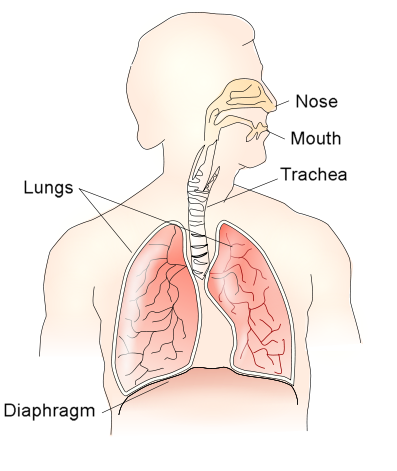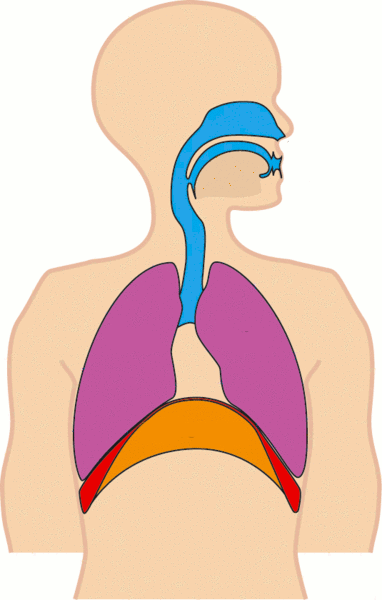Breathing in Clinical Somatics exercises
Many students ask me how to breathe correctly when practicing Clinical Somatics exercises. Your breathing pattern is more important in some exercises than others, depending on whether or not the exercise includes extension (arching) or flexion (curling) of the spine.
In this article I’ll describe why diaphragmatic breathing is important, the general principle of how to breathe when practicing Clinical Somatics exercises, and some step-by-step examples of how to breathe in specific exercises. The bottom line is that you should breathe as much as you need to and never hold your breath; but, learning how to breathe in the following ways will allow you to get the most benefit from your Clinical Somatics practice.
If you find that you have trouble taking deep breaths and allowing your belly to expand, or if you have a tendency to breathe through your mouth, please read How to Relieve Shallow Breathing.
Why we practice diaphragmatic breathing in Clinical Somatics exercises
As you can see in the diagrams below, the diaphragm is an umbrella-shaped muscle located just below our lungs. In diaphragmatic breathing, we contract our diaphragm, pulling its center downward and inverting its umbrella shape as we inhale. This action draws air into our lungs, and pushes the contents of our belly forward. So, our abdominal muscles must be able to fully relax in order to allow us to take a full inhale and let our belly expand forward. Then as we release our diaphragm, it relaxes upward and expels the air out of our lungs.


A form of diaphragmatic breathing occurs naturally and automatically in all mammals when they are in a state of relaxation. This type of breathing is known as eupnea and requires no conscious effort. In the state of eupnea, the diaphragm and external intercostal muscles automatically contract to draw air into the lungs. The abdominal muscles are relaxed, allowing the belly to gently expand forward during inhalation. The chest also expands during inhalation, and the collarbone and shoulders will subtly rise. During exhalation, the belly, chest, collarbone and shoulders all return to their neutral resting position.
When we become stressed for any reason, however, we instinctively shift to shallow breathing. This type of breathing involves drawing air into the lungs using the intercostal muscles (the muscles in between the ribs) instead of the diaphragm. As a result, in shallow breathing the chest expands instead of the belly.
The most common physiological issue associated with shallow breathing is a heightened level of stress due to constant activation of the stress response. Stress causes us to breathe shallowly, and if we experience stress on a regular basis, our shallow breathing becomes habitual. We continue to breathe shallowly whether or not we’re experiencing stress, and the shallow breathing itself actually activates our stress response.
Shallow breathing is also associated with anxiety disorders, panic attacks, hyperventilation, shock, asthma, pneumonia, pulmonary edema, and a buildup of carbon dioxide in the body known as hypercapnia.
Since habitual shallow breathing triggers our stress response—which includes increasing our muscle tension—we want to make sure we’re breathing diaphragmatically while we practice Clinical Somatics exercises. If you find that you have trouble taking slow, deep breaths and allowing your belly to expand, please be sure to read How to Relieve Shallow Breathing.
Arching and Flattening: Natural extensions of inhaling and exhaling
So, the first guideline to breathing in Clinical Somatics exercises is that you should always try to breathe diaphragmatically. The exercises will be most effective if you are completely relaxed and not holding your breath.
The second guideline is that you should inhale as you do any sort of Arch or extension of your spine, and exhale as you Flatten, Curl, or do any sort of flexion of your spine.
Here’s why: Extension and flexion of the spine are natural extensions of the movements of inhaling and exhaling.
When you inhale, your diaphragm moves downward and your belly expands. If you are relaxed, you should feel a gentle, natural extension or arching of your spine as you inhale. When you want to take a really deep inhale, you may notice that you actively arch your back to create more space in your chest and abdomen.
When you exhale, your lungs empty and your belly returns to normal. If you want to expel the air from your lungs more completely or forcefully, you can contract your abdominals and internal intercostals to reduce the space in your abdomen and chest.
If you try to do the opposite—inhale while doing a Flatten or Curl, or exhale while doing an Arch—you’ll find that it feels difficult and unnatural.
How to breathe in specific Clinical Somatics exercises
Let’s start with the Arch & Flatten:
- 1. The Arch: Inhale into your belly as you roll your pelvis forward, arching your lower back.
- 2. Exhale and breathe as you need to as you very slowly release the muscles in your lower back to return to neutral. If you’re moving very slowly, you may need to take several breaths as you return to neutral. Please note: This is not the Flatten; this part is simply the release out of the Arch.
- 3. While you’re resting in neutral, inhale down into your belly.
- 4. The Flatten: Exhale as you flatten your lower back down into the floor.
- 5. Breathe as you need to as you release out of the Flatten. If you are moving very slowly, you may need to take several breaths as you release back to neutral.
You can follow this pattern for the Arch & Curl, One-Sided Arch & Curl, Diagonal Arch & Curl, Flowering Arch & Curl, and Diagonal Curl.
The same pattern applies to the Side Curl:
- 1. Inhale while you’re resting in neutral.
- 2. The Curl: Exhale as you curl up to the side.
- 3. Breathe as you need to while you release back down to neutral. If you’re moving slowly, you may need to take several breaths as you release.
In the Back Lift, I instruct that you should inhale during the back extensions: the lifting of the head, the lifting of the head and arm, and the full movement. You can also inhale as you lift your leg. Apart from those inhales, simply breathe as you need to. You will likely need to take several breaths as you release out of the back extensions.
Recommended reading:
The Pain Relief Secret: How to Retrain Your Nervous System, Heal Your Body, and Overcome Chronic Pain by Sarah Warren, CSE
Somatics: Reawakening the Mind’s Control of Movement, Flexibility and Health by Thomas Hanna

